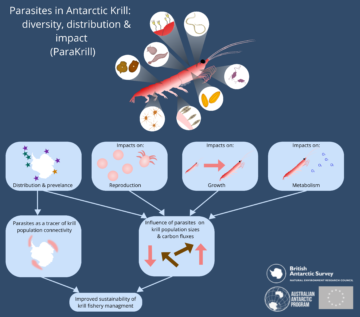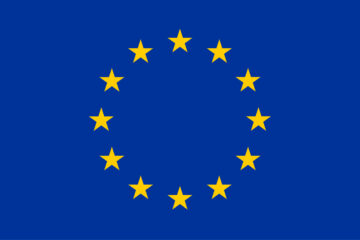ParaKrill
Parasites in Antarctic Krill: diversity, distribution & impact
- Start date
- 1 September, 2021
- End date
- 31 August, 2024

Krill are essential components of Antarctic ecosystems – they are important prey for fish, seals, penguins, and whales, and they influence carbon and nutrient cycling. This keystone role of krill means that in order to sustainably manage human impacts on Antarctic ecosystems, we need to understand the factors which influence krill populations.
One factor we don’t currently know much about is the role of parasites. Parasites are difficult to see within krill, and so until recently have been thought to be relatively rare in the Antarctic. Emerging genetic tools offer a more sensitive way to detect parasites, and early data suggests parasites may infect as many as one in ten krill, in certain times and places (Cleary et al. 2019). We don’t yet know exactly what parasites infect krill, how common they are, or how this might vary around Antarctica, or over time.
We also don’t know how these parasites might impact krill. When we look at parasites in other animals related to krill, we see that some parasites appear not to affect their host very much at all, some parasites make their host grow more slowly or have fewer offspring, and some parasites (called parasitoids) even kill their host.
In the ParaKrill project we will generate new data on the types & distributions of parasites infecting krill, and on the impacts parasites have on the infected individuals. By combing these different types of data, we aim to get a better understanding of what role krill-parasite interactions play in Antarctic ecosystems. How much do parasites influence the number of krill in the ocean? Do parasite infections affect how carbon and nutrients move through the ecosystem? We will know more soon, and can use this knowledge to better model and manage human impacts in the Antarctic.
We will also test if parasites can serve as a kind of natural “tag”, and whether that tells us anything about how much different groups of krill around Antarctica interact with each other. This is important to know for managing fishing for krill – if all the krill mix together often, it doesn’t really matter where you fish, but if krill stay in separate groups in separate places, fishing too much in one place could cause local problems. We are optimistic that parasites will be a useful new tool to answer this important and long-standing question.
This project will run from September 2021 – September 2023, split between British Antarctic Survey and the Australian Antarctic Division. We are very interested in both scientific collaboration and public engagement, so please feel free to get in touch (alleary@bas.ac.uk).
Cleary, A. C., Casas, M. C., Durbin, E. G., & Gómez-Gutiérrez, J. (2019). Parasites in Antarctic krill guts inferred from DNA sequences. Antarctic Science, 31(1), 16-22. (link) https://www.cambridge.org/core/journals/antarctic-science/article/parasites-in-antarctic-krill-guts-inferred-from-dna-sequences/69AC76C540BF5DDA8644B09CABEF9B0F
People in the project:
Alison Cleary (PI) – https://www.bas.ac.uk/profile/user_3482-2/
Geraint Tarling – https://www.bas.ac.uk/profile/gant/
So Kawaguchi – https://www.antarctica.gov.au/science/meet-our-scientists/dr-so-kawaguchi/
Funding
This project has received funding from the European Union’s Horizon 2020 research and innovation programme under the Marie Sklodowska-Curie grant agreement No 887760.
